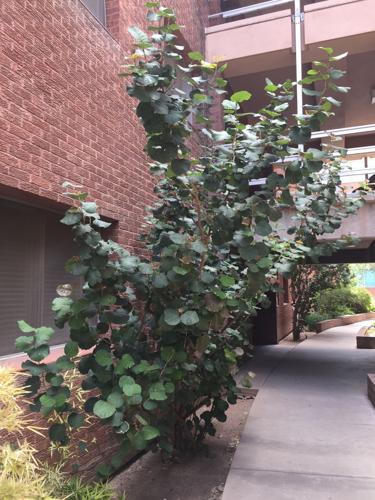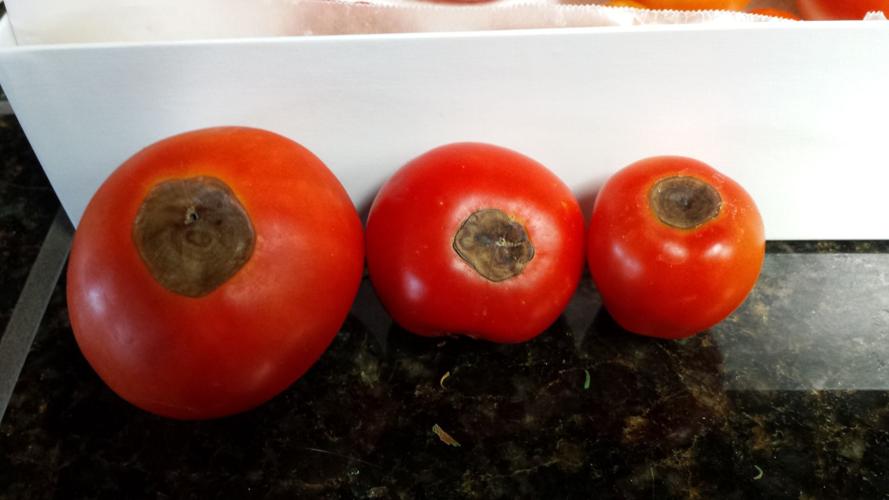Question: I saw Sonoran sea grapes growing near the Shantz building on campus, and I am wondering if I can grow them in a shady area in my yard that is part of our gray water (laundry to landscape) system. I did a little Googling and didn’t find anything about Sonoran sea grapes specifically, but came across something related to sea grapes in Florida, and the person said they are edible. Is that true of the Sonoran variety? I was attracted to them for their leaf shape, but edible berries would be a nice bonus.
Answer: The Sonoran sea grape (Coccoloba goldmanii) planted on campus is native to Sonora, Mexico. Sea grapes are in the Polygonaceae family, which includes buckwheat, knotweed, and smartweed, and the fruit of the related Florida species, Coccoloba uvifera, is reported to be edible and tasty. I can’t vouch for the fruit of the Sonoran species because I haven’t seen them flower or produce fruit. If you look for one to buy, you might need to look at the native plant nurseries in the area. In the intermediate desert around Tucson, this should be planted in partial to full shade to protect it from full sun. It’s also sensitive to frost so plant it in a protected location. It can grow to be a 25 feet tall tree with a width 6 to 12 feet. The two you saw on campus have been there quite a while and have been growing slowly so you might consider that aspect. Like other desert trees and shrubs, it needs a good soak every two weeks or so in the warm months. When it’s cooler you can back that off to once a month.
Question: I am growing tomatoes in the backyard, using organic fertilizer every two weeks, and I am getting black spots on the bottom of the tomatoes. What is it and can I control it?
Answer: Your tomatoes have blossom end rot. Blossom end rot shows up as a dark, sunken, leathery spot on the bottom or blossom end of the tomato fruit. This often happens in late spring and early summer following a heavy fruit set, a sustained dry period and/or if your fertilizer lacks sufficient calcium. To avoid blossom end rot, the fruit should be thinned, adequate irrigation provided, and a fertilizer with calcium should be used. Calcium, as well as other nutrients, moves slowly in water stressed plants so it’s possible that irrigation alone can solve this problem if you are already providing adequate calcium in your fertilizer.
Question: Your name came up regarding tree tobacco plants. If you wouldn’t mind sharing some thoughts on the tobacco plant. We have one growing right next to our Tucson house and it’s big. My wife is concerned it will harm the foundation. It seems to be a “soft” tree and I think it’ll be fine. Any experience in this matter?
Answer: Tree tobacco (Nicotiana glauca) can grow quite tall but you are correct in that it isn’t a woody plant that will do damage to your home. Many people consider this plant to be a weed but others like the yellow flowers so it’s up to you to decide whether to allow it to continue to grow.
Question: We have a wild palo verde in our front yard that has several branches near the outer edge of the crown that are dense broom like in appearance. I’m wondering if this is a type of mistletoe or some other disease and if so any suggestions on long-term survival?
Answer: Palo verde trees (Parkinsonia species) are sometimes affected by what is called a witches’-broom. This abnormal growth is not mistletoe but rather another problem. These brooms have for many years been attributed to a plant response to mites feeding on the branches. In recent years, further research was initiated and continues at the University of Arizona to determine if there is another cause and a solution. I am sure that the results of this research will be publicized as soon as they are available. Until then, there is little to do about the brooms except pruning them out of the tree. They often grow back so it isn’t a very satisfying remedy.





